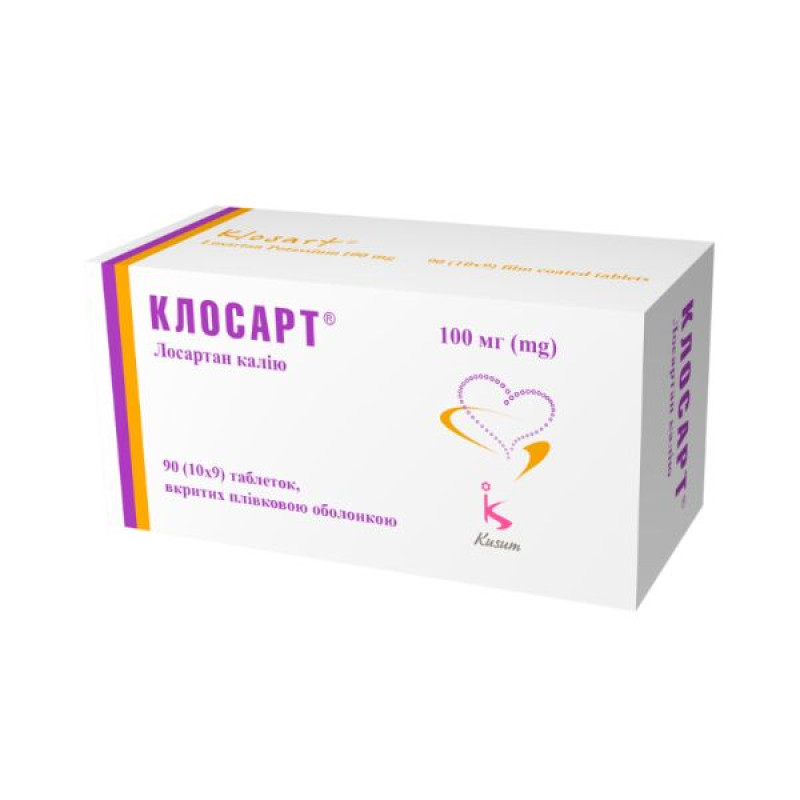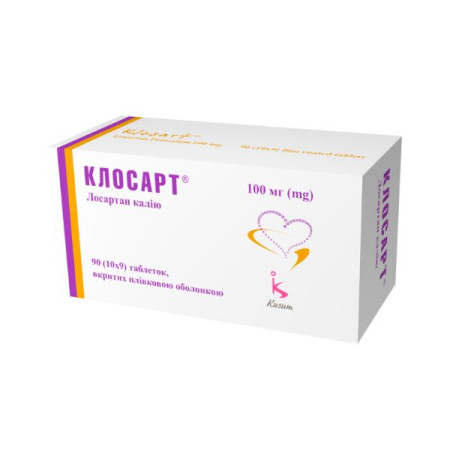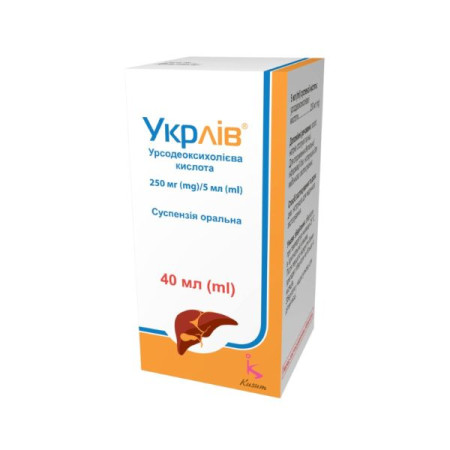Closart film-coated tablets 100 mg No. 90

Closart tablets are indicated for:
Treatment of essential hypertension in adults and children aged 6 years and over. Treatment of kidney disease in adult patients with hypertension and type 2 diabetes mellitus with proteinuria ≥ 0.5 g/day - as part of AT. Treatment of chronic heart failure (in patients aged 60 years and over) in cases where the use of ACE inhibitors is considered impossible due to intolerance (especially in case of cough) or in the presence of contraindications. Reduction of the risk of stroke in adult patients with hypertension and left ventricular hypertrophy, documented by ECG.Composition
Active ingredient: losartan;
1 tablet contains losartan potassium 25 mg, 50 mg or 100 mg;
Excipients: microcrystalline cellulose, croscarmellose sodium, magnesium stearate, colloidal silicon dioxide, Opadry O3B 52014 yellow *.
* Opadry O3B 52014 yellow: iron oxide yellow (E 172), quinoline yellow (E 104), hydroxypropylmethylcellulose, polyethylene glycol, titanium dioxide (E 171).
Contraindication
Hypersensitivity to losartan or to any of the excipients. Severe hepatic impairment. Pregnant women or women planning to become pregnant. Concomitant use of losartan and aliskiren is contraindicated in patients with diabetes mellitus or renal impairment (GFR <60 ml/min/1.73 m2).Method of application
The tablets should be taken regardless of meals, with a glass of water.
Arterial hypertension. For most patients, the initial and maintenance dose of losartan is 50 mg once daily. The maximum antihypertensive effect is achieved 3-6 weeks after the start of treatment. Some patients may benefit from increasing the dose to 100 mg once daily (in the morning).
Losartan can be used in combination with other antihypertensive drugs, especially with diuretics (e.g., hydrochlorothiazide).
Application features
Pregnant women
Not recommended for use.
Children
The safety and effectiveness of losartan in children under 6 years of age have not been established.
Drivers
With caution.
Overdose
Data on overdose are limited. The most likely manifestations of overdose are hypotension and tachycardia; bradycardia may be a consequence of parasympathetic (vagal) stimulation.
Treatment. Treatment depends on the length of time since taking the drug, as well as on the nature and severity of the symptoms. The priority measure should be to stabilize the function of the cardiovascular system. After taking an overdose, the use of activated charcoal in an appropriate dose is indicated. Later, the main vital signs of the body should be monitored frequently and adjusted if necessary. Losartan and its active metabolites are not removed during hemodialysis.
Side effects
Nervous system: dizziness, drowsiness, headache, insomnia, muscle cramps, paresthesia, stroke, migraine, dysgeusia. Psychiatric: depression. Heart: palpitations, fainting, angina, tachycardia, atrial fibrillation. Vascular: symptomatic hypotension (especially in patients with intravascular dehydration, for example, in patients with severe heart failure or when treated with high doses of diuretics), dose-dependent orthostatic effect. Gastrointestinal tract: abdominal pain, dyspepsia, constipation, diarrhea, pancreatitis, nausea, vomiting. Digestive system: hepatitis, liver dysfunction. Respiratory system: cough, shortness of breath, runny nose, sinusitis, pharyngitis, upper respiratory tract infections. Renal and urinary disorders: changes in renal function, including renal failure in patients at risk (such changes in renal function may be reversible upon discontinuation of therapy), urinary tract infections. Blood and lymphatic system disorders: anemia, thrombocytopenia. General disorders and administration site conditions: asthenia/weakness, fatigue, edema, flu-like symptoms.Interaction
Other antihypertensive agents may potentiate the hypotensive effect of losartan. Other drugs that may cause hypotension include tricyclic antidepressants, antipsychotics, baclofen, amifostine. The primary or side effect of concomitant use of these drugs with antihypertensive agents may be an increased risk of hypotension.
Storage conditions
Store at a temperature not exceeding 25 °C in the original packaging.
Keep out of reach of children.
Shelf life - 3 years.
There are no reviews for this product.
There are no reviews for this product, be the first to leave your review.
No questions about this product, be the first and ask your question.





